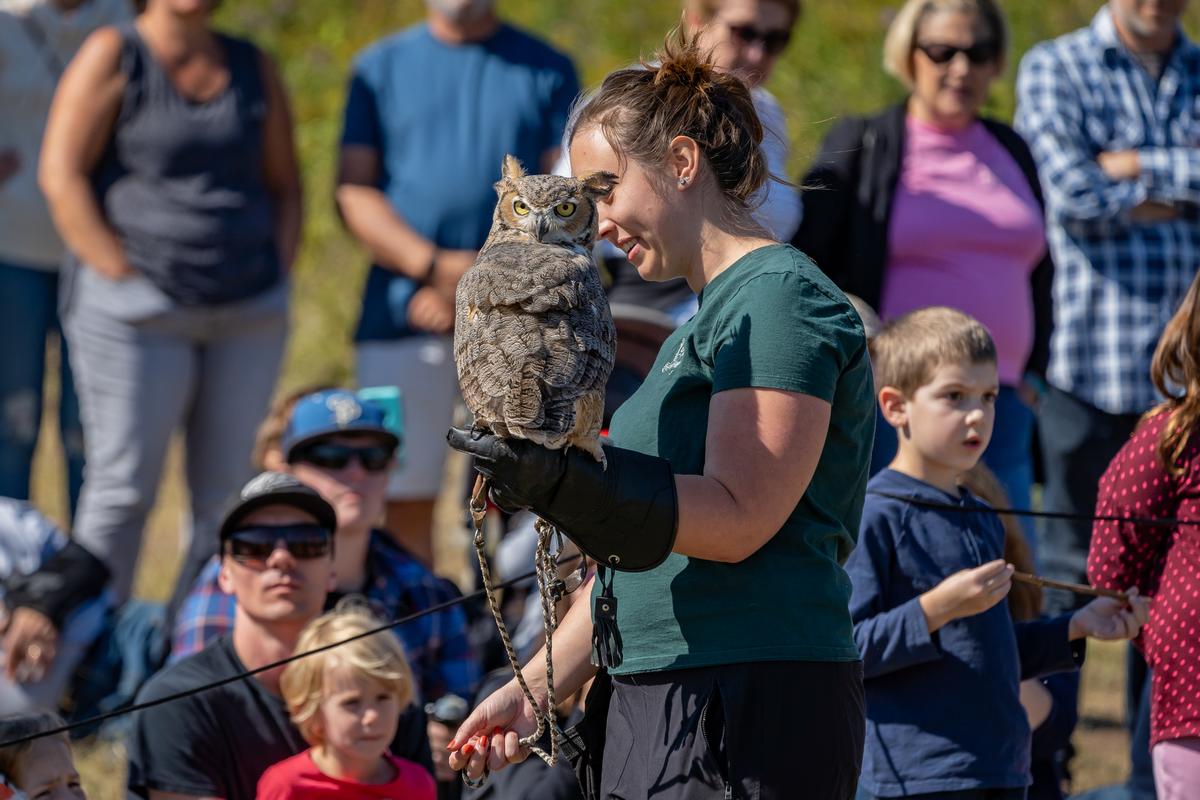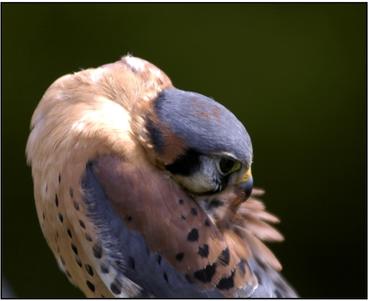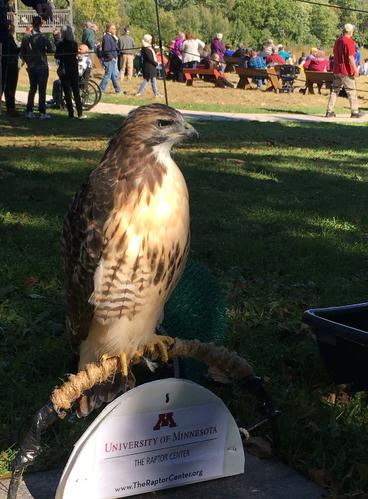
| Photo by Les Conrad
No bird’s journey to The Raptor Center (TRC) is exactly alike, and the same can be said for their life after receiving care at its clinic.
Raptors are ultimate athletes and need nearly perfect function to survive in the wild. Despite the expert medical care they receive at TRC, sometimes returning them to the high level of function required to survive in the wild is not possible, and a few raptors are given the opportunity to accept a new role as educational ambassador.

| Photo by The Raptor Center
As the title implies, these special birds become the face of educational programs both at TRC and other permitted facilities, such as nature centers and environmental learning centers. They accompany education staff on outings to schools, community events, and other settings. Not every raptor is a great fit for the ambassador role, but those who are help educate thousands of people each year about the importance of conservation and inspire audiences to take action in preserving the world around them.
Kelsey Griffin, an interpretive naturalist for TRC, sees that inspiration firsthand when she brings raptor ambassadors to meet audiences. When the raptor is taken out of its carrier, she says, energy often fills the air or a hush falls over the crowd.
“It’s just incredible because you really get a sense of the powerful ability of these birds to capture people’s imaginations and really make a lasting impact, ” she says. “It is an amazing feeling to generate that kind of excitement and help people connect with the environment around us. ”
Picking potentials
Earning the title of ambassador requires birds to undergo a thorough evaluation and training process. So what makes a raptor a good candidate for becoming an ambassador? First, it needs to pass a thorough medical and behavioral assessment. There are several factors that staff evaluate to determine if a bird would thrive in this new role, according to assistant director Lori Arent, MS.
The first factor is the species itself because some do not manage well in captivity and are less adaptable; they are more prone to stress. The next factor is age. In general, raptors that are less than a year old tend to adapt better to life in captivity than their older counterparts. The type of injury that made the bird no longer releasable also plays a role.
“We want to make sure that the bird can perform natural and enriching activities, ” Arent says. “It doesn’t necessarily need to fly strongly, but we want to be sure it can easily move between perches, tear up and eat whole food, bathe, preen its feathers, and engage with its surroundings. ”
Additionally, TRC staff members want to make sure the injury isn’t the type that could lead to chronically painful conditions, such as arthritis.
Assessing behavior
Once a bird passes its physical exam, staff turn to evaluating its behavior. This includes assessing the raptor’s temperament and habits.
“What we look for is a bird that has adapted to being in captivity fairly well, ” Arent says. “So it has a good appetite, is reasonably calm when in view of people/activity outside its housing space, and it demonstrates comfort behaviors, such as stretching, preening, standing on one foot, or bathing. It is also “tested” to see if it is willing to engage with a trainer on a superficial level. ”
Another behavioral evaluation that is often needed for young raptors is to determine their imprint status. "Imprinting" refers to the complex process of learning that young raptors undergo in the nest to develop their sense of self-identification. If unqualified people find youngsters out of the nest and raise them for any period of time, these youngsters become imprinted on humans instead of their own species. The result is that these birds behave inappropriately for survival in the wild and sometimes demonstrate aggressive behaviors toward people as well.
Learning the ropes
For birds that join TRC’s education program, passing a physical and behavioral assessment is only part of their journey. Training to become an ambassador is a series of tiny steps to allow a raptor to become acclimated to their environment and the presence of people.
Ambassadors-in-training are first housed in secluded settings to make the transition to permanent captivity as least stressful as possible. Then it’s on to helping the raptor feel comfortable eating with people in the vicinity, first with the main trainer and then slowly introducing the presence of other people, Kelsey Griffin says.
Food plays an important role in the training process. It is used to positively reinforce (reward) desirable behaviors so they will occur again. However, when first starting, staff use a method called “approach and retreat.” Trainers approach the bird with food, stop right before they elicit a stress response, and then retreat a little to give the bird control over how it’s approached.
| Photo by The Raptor Center
“That conveys a lot of information to the birds. They learn that they have the ability to modify your behavior by what they’re doing,” Griffin says, “and that’s a fundamental building block of their training—they can do things that will change what you do. They have control over their environment by their actions. So it’s really important information for them to get right off the bat while also getting them to be more comfortable with people in their space.”
Associating food with positive experiences through choice based training builds a foundation for adding new tasks, such as teaching birds to step onto a trainer’s gloved hand, enter a carrier for transportation, and acclimate to new people, places, and items around them as they enter new environments.
Hitting the road
Once trainers feel a raptor is ready, they begin to prepare the bird for public appearances. The ambassador-in-training is introduced to small groups of people at TRC and works its way to larger, more energetic groups.

Another part of that process involves acclimating the raptor to being housed in a carrier inside a moving vehicle for off-site programming. Trainers want the bird to be comfortable, and that means employing some effective but unconventional training techniques.
“You do things like driving in circles around campus, feeding the birds pieces of meat through the crate windows so they get used to this kind of movement and processing,” Griffin says. “We want them to know this is a really good thing that’s happening and there’s really nothing to worry about.”
The end result of all this training is a bird that is secure when it comes to appearing in front of crowds in a variety of situations. Depending on the species and individual, this can take anywhere from six months to over a year. Some of TRC’s ambassadors have been on the job for decades and have willingly participated in educating thousands of people.
It’s important to note that these birds are not performers but rather partners in education with their trainers. The choice is always theirs when it comes to the role they play in programming.
“We really want them to be actively choosing to participate in what we’re doing, ” Griffin says. “So anytime we have a bird out seeing visitors or going on programs, it was given the opportunity to choose to engage with us. ”